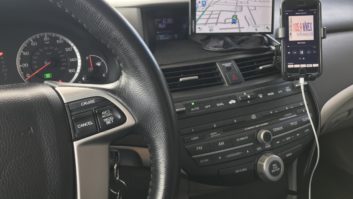NEW YORK WOR(AM) began transmitting a digital signal in addition to its analog on Oct. 11, the day after the FCC gave its initial endorsement to IBOC. The station had received experimental authority to go digital before the commission formally acted on Oct. 10.
WOR claims to be the first 50 kW AM in that state to go digital and has changed its slogan to “710 WOR-HD.” The station’s experience is being watched closely because of its size, because it is in New York and because it is on AM.
Engineers for the Buckley Broadcasting station expressed pleasure with both the analog and digital signals they were hearing.
“It sounds like FM,” said Chief Engineer Kerry Richards. WOR personnel could hear the digital signal on HD Radios as they rode around the area in Ibiquity’s test van. Ibiquity provided another digital radio for the transmitter site.
What does he think of HD Radio? “Give me radios. We need them now. For AM broadcasters, this is a Godsend,” said Richards.
As AM IBOC is authorized only for daytime use at this time, WOR is transmitting the hybrid signals during the day, and operating analog-only at night.
The analog signal is being transmitted at full power; the aggregate power level of the digital signal is 6 dB lower than recommended, at 22 dB below the main carrier. Buckley Director of Engineering Tom Ray said Ibiquity requested that the station use the lower level, so its engineers could study the effects on WOR’s analog signal and that of its neighbor stations.
WOR is using a four-year-old Harris DX 50 transmitter with two CAT-5 cables running from the Ibiquity exciter into a three-tower directional array with no pattern change to the antenna. The conversion took approximately three hours with one modification to the transmitter, fixing a relay in the oscillator circuit.
Ray and Richards disputed published reports in some trade press which surmised that the first digital exciter Ibiquity provided to WOR had “overheated.” The unit failed on Oct. 14; WOR turned off the digital signal before noon and switched to the auxiliary transmitter. The station was back on the air with just its analog signal. The reason for the failure was undetermined at press time.
The next day, Ibiquity supplied another exciter, and the station returned to IBOC transmission by day.
The WOR engineers said they received only one complaint in the first few days about increased noise on the analog signal, from someone listening on a wide-band radio. It received no immediate complaints about interference from other stations in the area. Both Richards and Ray said several engineers from surrounding stations had asked them about the conversion.
They both reported receiving calls from listeners who said the station sounded better. The engineers surmised the analog probably sounded louder because they had lowered the station’s bandwidth to 5 kHz.
The approximately 8.4-second delay built into the technology is not a problem for talent monitoring WOR, the engineers said; the format is talk, so the air staff already works with a delay.
WOR has invited listeners to tell the station what they think of HD Radio, and has provided a form on its Web site at www.wor710.com.
WOR plans to participate in Ibiquity’s nighttime AM tests, but was not sure when those would begin.



